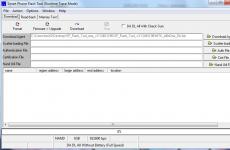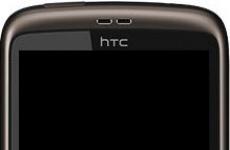How to do battery calibration on android. Battery Calibration Practical Guide - Tips & Instructions
Battery issues are among the biggest concerns for smartphone users, and it is because of this that we offer many helpful tips to deal with battery drain issues. If you notice that the performance and runtime of your battery has decreased, then it's probably time to do a battery calibration. So, today we will look at what calibration is, how to find out what needs to be done and how, with or without root rights.
How do I know if there is a problem with my battery?
First of all, find out why your battery performance has decreased: is it the battery itself or the calibration of the Android OS? We'll talk about calibration next, but first you need to check the battery for damage.
If your phone has a removable battery cover, then turn off the phone, remove this cover and inspect the battery. Look for bulges, electrolyte leaks, or swelling. In the presented photo you can see a swollen battery and its raised non-removable back cover. On phones without a removable battery, be sure to pay attention to such things, or to a phone that does not lie flat on the table.

If you are satisfied with your battery (found out that everything is fine with it), then you can proceed to the next steps. If you think there is something wrong with the battery (even after re-calibration), then we recommend that you take it to a repair shop for a specialist examination. If it turns out that the battery needs to be replaced, then purchase either the original one or a similar one from another manufacturer. Saving on cheap batteries can only lead to headaches in the future.
Keep in mind that there are many other things that can cause a battery to fail. If your phone is not charging, then there might be a problem with the charging port.
If you've recently updated your phone's hardware, then running out of battery is a common occurrence, and you'll probably want to clear your phone's cache partition.
What does it mean to calibrate a phone?
The Android OS has a feature called "Battery Status" that allows you to find out data about the capacity of your battery (when it is charged or discharged). The problem in this case is that at a certain moment the battery starts to work incorrectly and, as a result, incorrect information about it is displayed on the display. This can cause the phone to turn off even before the “0 percent battery level” value. Battery calibration is needed in order for the Android OS to receive reliable data about the battery, that is, about the actual charge level of your battery.

It is important to understand that you will not be able to do the calibration for real, because in fact, the battery is just a reservoir that stores energy and uses it up. However, lithium-ion batteries include a special circuit board that serves as a protection against explosion or deep discharge.
Myths about phone batteries
Lithium-ion batteries don't have a "memory effect" so it doesn't take much from you to get them to work properly. The problem is that how the Android OS reads and displays information about the current capacity of the battery, and not about the battery itself.
The same goes for the myth that deleting the batterystats.bin file will calibrate the battery.

Note that this file (at least on many devices) simply contains information about what consumes battery power when it is not charging. This file is also updated every time the battery has been charged over 80 percent and then unplugged.
The batterystats.bin file contains the kind of information you see enhanced in the Battery section of your phone: Android OS displays and stores battery usage data from one charge to the next. When we talk about battery calibration, we mean the percentage charge counter, which began to work incorrectly and needs to be debugged.
Android battery calibration without root rights
The former principle of "full charge and discharge" is one of the most simple ways to calibrate your battery. We have warned you in the past about low voltage problems in lithium batteries and the negative impact of a full battery drain on battery life. But if your battery is giving you serious problems, then it's worth taking the risk.

- Discharge your phone completely (until it turns itself off).
- Turn it back on and wait until it turns off again.
- Now you need to discharge the battery to 0 so that the phone turns itself off.
- Fully charge the battery again without interrupting the charging process, and then you need to restart the Android OS charging indicator.
Remember that this process is not recommended to be repeated frequently. Even if your battery is so "dead" that it is not capable of activating the phone, there is still enough energy in it that there is no damage to the OS. Again, we remind you that the above actions can be performed no more than once every three months. If you do this more often, then you may have more problems.
Also keep in mind that completely draining the battery is very harmful to it, and attempts to overcharge the battery also reflect badly on it. The good news is that battery charging automatically stops when it reaches a certain safe level, and there is always a small charge left in the battery itself, even if the phone does not turn on. In general, only deep charge/discharge when you really need to, as it negatively impacts battery life.
Rooted Android Battery Calibration
To be honest, we're not too sure that deleting the batterystats.bin file has any significant effect on remaining battery readings, but there are users who say it works. So in the interest of truth, we will tell you about this method (by the way, different manufacturers use the batterystats.bin file for different purposes). In general, this process is almost the same as above, but with the addition of a step with the root application.

- Fully discharge your phone so that it turns itself off.
- Turn it on again so that it discharges again and turns off.
- Connect your phone to the charger, without using the "On" button and charge it until the LED indicator shows "100 percent charge".
- Disconnect Charger from phone.
- Turn off your phone. The battery indicator will most likely not show "100 percent," so reconnect the device to the charger and wait again until the display shows "100 percent charge."
- Disconnect the charger from your phone and restart your phone. If the charge level does not show the number "100", reconnect the phone to the charger and wait until the number "100" appears.
- Repeat the above steps until the "100" icon is displayed on the screen when you turn on the phone when it is not connected to the charger.
- Now install the "Battery Calibratoin" application and, before launching it, make sure that the charge indicator shows the "100 percent" mark, and then restart.
- Launch the app immediately and calibrate your battery.
- After you have done the battery calibration, drain it to 0 so that the phone turns itself off.
- Fully charge the battery (without interrupting the charging process), then you need to reset the Android OS charging indicator.
That's all. Have you actually tried one of these methods? Do you know of any alternative way to solve the battery problem? Write about it in the comments.
Modern man cannot be imagined without mobile phone and tablet computer.
We use these devices more than once every day, and some almost never let go of their gadget. But the more a person uses his electronic equipment, the faster its battery is discharged.
Based on this, the question arises - is it possible to somehow extend the operation of a smartphone or personal computer? It is possible, and there is a solution to this problem - you just need to calibrate the battery of the gadget. When should this procedure be carried out?
- If new smartphone actively used for about 2-3 days and the amount of charge remained the same;
- If the phone's battery starts to run low quickly.
There are two ways to calibrate the battery - using a special program and "manually". So, if the battery of your android device is not enough for you all the time, let's proceed to calibration.
The first and easiest way to calibrate an android battery:
You will need to download from Play market a special program for calibrating the battery "Battery Calibration" and install it on an electronic device.
It is suitable for all types of equipment and is installed on both the phone and the tablet with operating system android. After installation, run the program and follow the information on the screen of your electronic device.
The battery itself will perform all the manipulations, and the calibration will be done and completed.
One caveat - to use the "Battery Calibration" program, Root access rights are required. If you do not have them, it is recommended to use.
You can use the second method of calibrating the battery
You will need free time and a strong desire to have a battery with a long time of active use. In this case, everything is done manually.
Let's start with the calibration:
- We charge the electronic device in the on state for 8 hours. Before that, it is recommended to completely discharge it so that the charge is 0%.
- Turn off your phone or tablet completely and charge it for another 2 hours when it is off.
- Unplug your device and turn it on for 2 minutes.
- Turn off your phone and let it charge for another 1 hour.
After these manipulations, an electronic device on android will delight its owners with a long battery charge.

This method of battery calibration is suitable for both a smartphone and a tablet, since both devices charge in exactly the same way. Battery calibration is recommended for all types of devices that for some reason do not charge to 100%.
There are such situations, and instead of going to the service and giving your device for flashing, try to handle it on your own first.
There will definitely be no harm from this manipulation, but the battery power will definitely increase, and your gadget will keep the charge much longer.
This video shows another way to tune the battery.
When a smartphone is new, its user is of little concern, because the gadget brings a lot of positive emotions and does an excellent job with the tasks assigned to it. But everything is not eternal, and technology has such a property as aging and wear of parts and deterioration of the overall work. Probably the very first thing that begins to annoy the user is the phone's battery. And in today's article we will look at several methods on how to improve its condition by calibrating.
What is and why battery calibration is needed
In every smartphone or tablet that is based on Android or iOS platform there is a special controller that is responsible for the limits of the charge and discharge of the battery. With the period of use, the battery loses its ability to hold a charge, this can also be observed when changing the firmware version or adding patches or launchers.
So, the battery calibration process resets the default settings and sets the charge and shutdown levels according to the current technical condition of the battery. As a rule, this has a positive effect on the duration and correct operation of the battery.
Android Battery Calibration
Everything is simple here, calibration in the Android platform is done using a special utility or program. We will look at two of the most popular of them - Battery Calibration and Advanced Battery Calibrator.
How to use Battery Calibration
First you need to download the program for free from the official website here. After installation, run the utility and follow the instructions:
With the program window open, connect the charger to your smartphone or tablet;
We are waiting for the device to charge up to 100%, then a beep will sound;
After a full charge, you still need to wait an hour;
Press the Battery Calibration button and wait for the end of the procedure;
Disconnect the device from the charger and reboot the gadget;
All procedure is completed.

The program will reset the controller memory and enter new technical values.
How to use the Advanced Battery Calibrator
Similarly, first we download the utility here, after launch we need to accept the conditions license agreement and follow the instructions:
We connect the charger with the program window open;
Click the Calibrate Now!
We are waiting for the completion of the process;
At the end of the procedure, turn off the device;
With Android turned off, we are waiting for the battery to be fully charged;
Turn off the charger and turn on Android.


All calibrations are complete.
Remember! With Android turned off, the time for a full charge during the calibration process is at least 6 hours for smartphones and at least 10 for tablets.
Battery Calibration on iPhone iPad
Devices running on the iOS system have always been distinguished by a long battery life compared to Android. Therefore, users are much less likely to ask the question of calibration.
At the time of this writing, there were no special programs for Android, and the whole process comes down to standard methods for increasing the service life: carry out a complete discharge and charge for at least 10 hours.
If you have any questions regarding calibration, we will be happy to answer them in the comments below the article.
Battery problems are one of the biggest problems that mobile device users can face. If you notice that the battery life of your smartphone or tablet has been drastically reduced, it is better not to put it off the shelf and start calibrating it.
So, in today's article, we'll look at how to calibrate the battery on Android.
Signs that the battery is bad
First of all, it is necessary to find out why the performance of the battery has deteriorated: the matter is in the battery itself or in the calibration system. Indeed, in case of physical damage, no software setting will help. Getting to the tablet battery is quite difficult. So don't try if you don't know how to do it right. With phones, everything is much easier.
There are times when a tablet is needed. How to make it will be described below.
Remove the back cover of the phone and remove the battery. Take a good look at it for bulges. Some smartphone models are equipped with non-removable batteries that are soldered into the device, or with covers of the same type. Then inspect the back panel to see if it sticks out. If your phone is no longer lying flat on the table, then that too could be a sign of bulges in the battery. If they are present on the battery, the smartphone should be taken to service center. Otherwise, learn on your own how to calibrate the battery on Android.

Also, don't forget that there are many other reasons for poor battery performance. For example, if the smartphone stops charging, most likely there is a problem with the charger port.
What is battery calibration?
How to calibrate the battery on Android? What is this process?
Every Android or iOS device has a dedicated controller that collects battery usage statistics. It determines the true amount of energy in the battery at the current time. Sometimes problems with this controller happen. It stops displaying real numbers, from which the phone can, for example, turn off ahead of time (that is, before the charge level reaches zero).
Calibration is needed to reset the default settings. It sets the charge level, according to the current technical condition of the battery.

How to properly calibrate the battery on Android without Root rights?
It should be noted right away that calibration will not increase the battery capacity, but will only force the controller to display the correct information. Which is also very important. The easiest way to calibrate the battery on Android is to fully charge and discharge, but this method can be bad for battery life. However, if the battery is giving you too much trouble, then it makes sense to take a chance.
- To begin with, let your device fully discharge until it turns off.
- Connect the charger to your phone or tablet and, without turning on the device, keep it on charge for several hours. It should be fully charged.
- Disconnect the charging cable.
- Turn on mobile device. Most likely, the indicator will report that the battery is not one hundred percent charged. Put the device on charge again, but now do not turn it off. It is necessary that the indicator shows one hundred percent.
- Repeat these steps until the indicator shows the correct information.
- After that, let the device fully discharge and turn off one more time, and then charge it again.

Android battery calibration: setting up the charge controller via Root
It should be reminded that it is not recommended to use the above method too often. Even when the battery is discharged to such an extent that the phone does not turn on, it retains a small charge, which helps to avoid system errors. But it is better not to tempt fate and manually calibrate the battery no more than once every three months. In simple words, a complete discharge or overload of the battery is extremely bad for it.
The next method is even more effective (and no less risky), but you need to get Root rights for it. So, how to calibrate the battery on Android using Root:
- Repeat the steps above.
- Install the Battery Calibration app. Before installing, make sure that the charge indicator shows one hundred percent. Reboot your device.
- Launch the application immediately. It will calibrate the battery itself.
That, in fact, is all. We hope that the question of how to calibrate the battery on Android is now resolved.
Probably, many were faced with the fact that a laptop or smartphone suddenly began to discharge or turn off by itself, even if their batteries had not yet had time to “grow old” thoroughly. If your device starts to give such signals, there is a high probability that it needs battery calibration in order to restore full operation.
The concept of calibration and the essence of its necessity
All modern gadgets and portable computers are equipped with capacious and durable batteries. These batteries, in turn, have a device inside called a controller. The controller controls the battery and all its options, its purpose is to read all the information about the charge-discharge of the battery of your device.
In some cases (for example, occasional recharging of the phone in a hurry, frequent USB charging from a computer) the controller goes haywire and starts to read battery information incorrectly . Then a quick shutdown of the phone or laptop begins to occur - not because the battery has exhausted its resource, but because controller is not working properly . For example, if the battery level is not yet critical (20%, 30% or more), the controller automatically turns off the battery and the device turns off.
To do this, you need to carry out such a simple procedure as calibrating the battery. It lies in the fact that all previous indicators of the controller are reset, and it returns to the correct state of its work . You can calibrate the battery of any device yourself.
Is calibration needed?
In order to finally determine whether your gadget needs to calibrate its battery, watch it carefully, and everything will become clear to you in a short time.
Signs that the controller is not working properly usually look like this:
- Carefully monitor the battery level of your device during current operation. If the charge, although small, is still in the battery, and the gadget suddenly turns off, then calibration is definitely necessary .
- The battery charge level is in the range of 20-30%, and the battery starts to lose its resource too quickly and “sits down”, after which the device also turns off .
- Follow the process of charging the battery. If charging occurs unevenly, "jerks", or with a long "freeze" - calibration is needed .
Battery calibration process
To calibrate the battery of your device, you will need a few simple steps:
- Discharge the device completely.
- Wait for it to turn itself off.
- Put in the off state to charge.
- Wait until the charger shows the 100% battery icon.
- Do not remove the device from charging - the controller does not accurately display the process.
- Continue to keep the gadget on charge for at least another two hours.
- Now reboot your device.
- Repeat the whole algorithm of actions two more times, remembering that it is necessary to discharge the battery to full zero, and charge it to full hundred percent
If you have enough patience and you do everything exactly, then the controller will restore its full operation.

How to extend the life of your battery
First of all, don't forget regularly calibrate the battery - in order to avoid the next failures in its work. Calibrate the battery every two to three months and this will help prevent the controller from "cycling" on incorrect readings.
Also do not abuse fast phone recharges using a usb device from a computer and - remember that frequent recharging can quickly bring down the controller again.
Moreover, do not expose your gadget to direct sunlight th. Lithium-ion batteries do not like sudden changes in temperature and can quickly lose their capacity if they are overheated or overcooled.
If you master self-calibration, your mobile device or laptop will work properly and clearly for a long time, and the battery will perform its life in the best and optimal way for it. The main thing is to follow all the recommendations exactly and monitor the condition of the battery.





